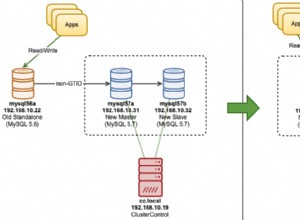W Oracle 11 możesz użyć pivot klauzula wraz z unpivot klauzula:
with
count_table as (
select 1001 device_id, 4 quantity from dual union all
select 1002 device_id, 20 quantity from dual union all
select 1003 device_id, 1 quantity from dual
),
device_table as (
select 1001 id, 'Yes' wifi, 'No' email, 'No' bluetooth from dual union all
select 1002 id, 'Yes' wifi, 'Yes' email, 'No' bluetooth from dual union all
select 1003 id, 'Unknown' wifi, 'Unknown' email, 'Yes' bluetooth from dual
)
----------------------------------------
select * from (
select
feature,
yes_no_unknown,
sum(quantity) quantity
from
count_table c join
device_table d on c.device_id = d.id
unpivot ( yes_no_unknown
for feature in (wifi, email, bluetooth)
)
group by
feature,
yes_no_unknown
)
pivot ( sum (quantity)
for yes_no_unknown in ('Yes' as yes, 'No' as no, 'Unknown' as unknown)
)
;
Alternatywnie możesz chcieć połączyć dwie istniejące tabele z trzecią tabelą, która zawiera wartości dla trzech żądanych wierszy. Prawdopodobnie jest też nieco łatwiejszy do odczytania:
with
count_table as (
select 1001 device_id, 4 quantity from dual union all
select 1002 device_id, 20 quantity from dual union all
select 1003 device_id, 1 quantity from dual
),
device_table as (
select 1001 id, 'Yes' wifi, 'No' email, 'No' bluetooth from dual union all
select 1002 id, 'Yes' wifi, 'Yes' email, 'No' bluetooth from dual union all
select 1003 id, 'Unknown' wifi, 'Unknown' email, 'Yes' bluetooth from dual
)
----------------------------------------
select
f.txt,
sum(case when ( f.txt = 'wifi' and d.wifi = 'Yes' ) or
( f.txt = 'email' and d.email = 'Yes' ) or
( f.txt = 'bluetooth' and d.bluetooth = 'Yes' )
then c.quantity
else 0 end
) yes,
sum(case when ( f.txt = 'wifi' and d.wifi = 'No' ) or
( f.txt = 'email' and d.email = 'No' ) or
( f.txt = 'bluetooth' and d.bluetooth = 'No' )
then c.quantity
else 0 end
) no,
sum(case when ( f.txt = 'wifi' and d.wifi = 'Unknown' ) or
( f.txt = 'email' and d.email = 'Unknown' ) or
( f.txt = 'bluetooth' and d.bluetooth = 'Unknown' )
then c.quantity
else 0 end
) unknown
from
count_table c join
device_table d on c.device_id = d.id cross join
(
select 'wifi' txt from dual union all
select 'email' txt from dual union all
select 'bluetooth' txt from dual
) f
group by
f.txt;




